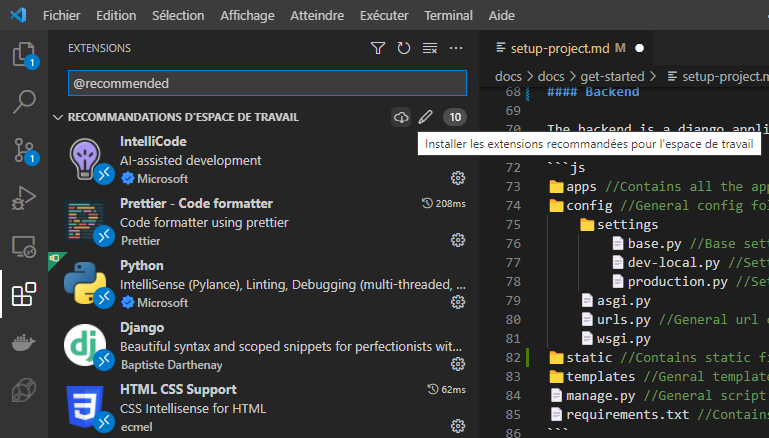Configure your tools
Now that's every softwares are installed, let's set up them!
Clone the repository
- Using Github Desktop
- Using VS Code
- Start Github Desktop
- Select "Clone a repository from the internet" (if you don't see the button, select
File > Clone repository) - Paste the repository url:
https://github.com/3cn-ecn/nantralPlatform.git, or only3cn-ecn/nantralPlatform, and clone the repository! - Wait during the download, and then click the "Open in Visual Studio Code" button (if you see another text editor, open the Github Desktop preferences and set the text editor to VS Code)
- Start by opening VSCode.
- Once your folder is opened, press CTRL + SHIFT + P (for Mac users: CMD + SHIFT + P), then type
Cloneand press ENTER. - In the prompt window, paste
https://github.com/3cn-ecn/nantralPlatform.git. - When prompted, select a folder where you want to clone the repository. This will create a folder named
nantralPlatformwhere everything will be stored. - Open the
nantralPlatformfolder in VSCode once the repository has ben cloned.
A detailed tutorial with screenshots is available here.
Set up VS Code
Install the extensions
The first time you open the nantralPlatform folder in VSCode,
you should see this pop-up:
Click the "Install all" button, and you're ready!
Oops, I decline the pop-up...
Don't worry, you can find all the recommended extensions in the extensions menu. Press CTRL+SHIFT+P, and search Extensions: Show Recommended Extensions. The list of all recommended extensions will appear on the left panel, and you can then click the download button to install them:

Discover the project structure
In VSCode, in the left panel, you can see the folder structure of the repository. Here are a few explanations about the purpose of the main folders.
📁 .github // Github Actions (CI and CD)
📁 .vscode // Config of VS code
📁 backend // Django project
📁 apps // each 'app' is a part of the website
📁 config
📁 static
📁 templates
📄 manage.py
📄 Pipfile // Dependencies file
📁 deployment // Docker files and back-up scripts
📁 docs // Documentation website (Docusaurus)
📁 docs
📄 package.json
📁 email-templates-generator // Generate HTML templates for emails in Django
📁 emails
📄 package.json
📁 frontend // React project
📁 src
📁 modules // equivalent to apps in Django
📁 pages // the pages the user see
📁 shared
📄 App.tsx
📄 package.json // Dependencies file
📄 Makefile // make update command
📄 README.md
The Backend
The backend is a django application. The most important files and directories are:
- apps: in this folder are stored the apps, i.e. a part of the website (for example we have an app for the clubs, another one for the rommates map, etc.)
- config: in this folder are stored the root urls and the configuration of django.
- static: in this folder are stored the static files of django, that is to say the files that are not part of the source code and should be not compiled by the server (for examples images, fonts, etc.)
- templates: this folder is about the main template of django, that is to summary the HTML page which is used as a base for every page
- manage.py: this file contains the main commands of django. For example,
you can use
python3 manage.py runserverto run the server. - Pipfile: this file contains the dependencies of the project,
and some shortcuts for everyday commands (for example we have the shortcut
pipenv run startforpython3 manage.py runserver). All shortcuts begin withpipenv run.
The Frontend
The frontend is an node.js application which uses React.js.
It is supposed to contain all the user interface, but for the moment we only have some pieces of interface defined in the frontend (like the notification panel or the roommates map for example). All the rest of the interface is defined in django, but in the future everything will be defined in the frontend.
The main structure is like this:
- src: contains all the source files of the react application
- package.json: contains the dependencies of the project, and also some shortcuts
(for example
npm run startto compile the source code in live). All shortcuts begin withnpm run.
The documentation website
The documentation website is a docusaurus application, also built with node.js.
- docs: this sub-directory contains all the pages of the doc website, in the markdown format. You can also use React component inside the pages!
- static: this folder contains all the static files of the documentation website, like images for example.
- package.json: contains the dependencies of the project, and some shortcuts
like
npm run startto compile and open the doc website on your computer.